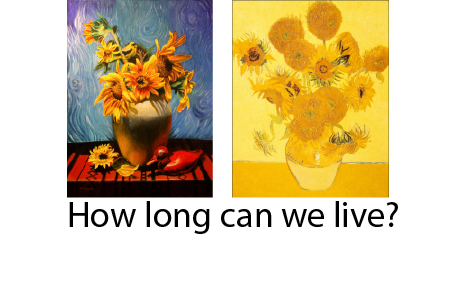
- Written:
- Author: Edward
- Posted in: breathing, diet, dr ed park, exercise, gratitude, Hay House, sleep, slice of life, The Telomere Miracle
- Tags: analogies, cut flowers, Dr. Ed Park, expectations, physiology, sunflowers, the telomere miracle
 I was surprised to see my sunflowers have lasted 12 days so I looked it up. According to the internet, they can last two weeks.
I was surprised to see my sunflowers have lasted 12 days so I looked it up. According to the internet, they can last two weeks.
The reason I bring this up is because in the past, I would occasionally change the water and expect them to be withering within four days or so. This time, I used my filtered water and cut the stems every few days so they could exchange metabolites. Apparently, adding sugar is even better!
Never one to let a good metaphor go to waste, I think this brings up the topic of human longevity. In my book, The Telomere Miracle: Scientific Secrets to Fight Disease, Feel Great, and Turn Back the Clock on Aging, I explain how breathing, sleep, mindset, diet, exercise, and supplements actually function and also how to optimize your own survival, like cut flowers that need to last.
In a nutshell, change your water (purge the mental waste you are creating), keep yourself fed (learning and loving), cut your stems (remain open to your world), and don’t assume that while we wait for a breakthrough we can’t do things to optimize our survival and our enjoyment of life (expect to live more than the usual unhealthy short lifespan).
Here is a review from a patient who didn’t see eye to eye with me on diet and supplements but that is to be expected and even welcomed. I hope that anyone can benefit from reading this book as it demystifies many aspects of physiology and will help you live better according to your own beliefs and potential. There is a lot of misinformation out there; this is my attempt to help.
February 11, 2018
Format: Hardcover|Verified Purchase
Bottom line: I found this book to be a real pleasure to read… and absorb. The title is a bit misleading: this is a book, yes, about telomeres and their pivotal role in the aging process, but it is far more than that – this book is also about improving one’s health and vitality in a number of ways.
Chapters 4-9 cover a variety of health topics (breath, mind, sleep, exercise, diet and supplements), and along the way the author discusses how these aspects of behavior affect telomere length. I found the breath and sleep chapters to be especially valuable for me: I had thought I knew a lot on these topics, but I learned some important and useful facts and, as a result, have made some dramatic improvements in these areas! (And have been helping my friends do the same.) Dr. Park has done his homework here, and his explanations are clear and convincing. He also mixes in humor, like when he told the story of “the first (and last) time I ever took a Bikram Yoga class…” because the “rather militant instructor singled me out—in front of 40 other participants—by shouting over the loudspeaker: ‘No, Ed! Bad!! You’re breathing through the wrong holes!’”
The chapter on “Your Mind” contains excellent descriptions of the autonomic nervous system and also contains lots of practical advice for calming stress. But it also was a bit spiritual for me, like being transported back to how I felt when I first read Eckhart Tolle’s “The Power of Now.” Reading from this chapter, I sat on the couch and felt peaceful as I pondered sentences such as: “I am part of life” (when the author was writing about “What is ego?”). He quotes the Sufi poet Rumi: “You are not a drop in the ocean. You are the ocean in a drop.”
I differ with the author on some of his diet and supplement recommendations, but nonetheless found his different perspective on these issues to be of interest to me… so I won’t quibble on these points.
Having said all that, this book is also an excellent primer on the science underpinning telomeres, cell biology and aging. The glossary at the end of the book is reason enough for me to keep this book on the coffee table (thus easily accessible) and off the bookshelf.

